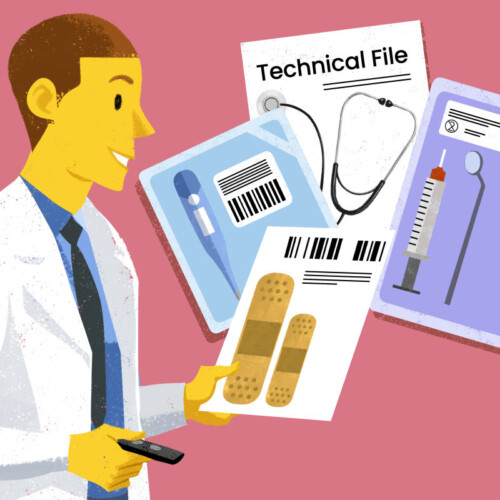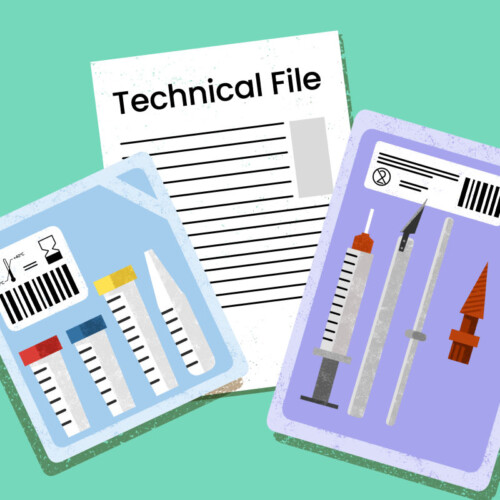The Medical Devices Regulation (EU) 2017/745 (MDR), which came into effect in 2017 to replace the directives (93/42/EEC on medical devices, MDD, and 90/385/EEC on active implantable medical devices, AIMDD), was amended in April 2020 (Regulation (EU) 2020/561). It had already provided for a transition period following the application date of the Regulation, by the end of which all medical devices needed to be certified under the MDR, including all legacy devices previously placed on the market under the MDD or AIMDD.
“Legacy devices” refer to:
– devices classified as Class I under the MDD, for which a CE declaration of conformity was drawn up before May 26, 2021, and for which the conformity assessment procedure under the MDR requires the involvement of a notified body;
– devices covered by a valid CE certificate issued under the AIMDD or MDD before May 26, 2021.
The transition period defined in Article 120 – Transitional Provisions – of the MDR, as amended by Regulation 561 in April 2020, could extend, at most, until May 26, 2024.
Over five years since the MDR came into effect, given the limited number of certificates issued under the MDR, and estimates of new certifications expected by May 2024 (considering the capacities of the notified bodies), the European Commission decided to extend the transitional period for placing legacy devices on the market or putting them into service to avoid shortages of devices in the market.
To do this, it amended the MDR with Regulation (EU) 2023/607, substantially modifying Article 120 on transitional provisions, and consequently adjusting Articles 122 and 123 of the MDR as well.
Regulation (EU) 2023/607 was published in the Official Journal and came into force on March 20, 2023; it grants additional time for manufacturers to submit their application for conformity assessment under the MDR, more time for notified bodies to carry out the necessary conformity assessment procedures, and simultaneously introduces a series of conditions for manufacturers to benefit from the extension and continue to place legacy devices on the market.
The new deadlines for the transitional period are defined based on the risk class of the devices, established according to the rules of Annex VIII of the MDR.
The shortest transitional period is granted to Class III implantable custom devices, which under Article 120, 3) septies, can be placed on the market or put into service until May 26, 2026, without a certificate issued by a notified body according to the conformity assessment procedure […], provided that by May 26, 2024, the manufacturer or authorized representative has submitted a formal application to a notified body […], for the conformity assessment, and by September 26, 2024, the notified body and the manufacturer have signed a written agreement in accordance with Annex VII, point 4.3, second paragraph.
The new transitional period applicable to legacy devices is instead detailed in paragraphs 3 bis and 3 ter of Article 120, as amended by Regulation (EU) 2023/607.
3 bis. Devices with a certificate issued under Directive 90/385/EEC or Directive 93/42/EEC that are valid under paragraph 2 of Article 120 (i.e., not yet expired as of March 20, 2023, or expired but with an agreement for MDR conformity assessment for that device or for a device intended to replace it already signed between the notified body and the manufacturer before expiration, or valid by virtue of a derogation granted by a competent authority of a Member State under Articles 59 or 97 (1)) – can be placed on the market or put into service until the following dates:
– December 31, 2027, for all Class III devices and for Class IIb implantable devices, except for sutures, staples, dental filling materials, orthodontic devices, dental crowns, screws, wedges, plates, and prostheses, wires, nails, clips, and connectors;
– December 31, 2028, for Class IIb devices other than those mentioned in letter a) of this paragraph, for Class IIa devices, and for Class I devices placed on the market in sterile conditions or with measuring functions.
3 ter. Devices for which the conformity assessment procedure under Directive 93/42/EEC did not require the involvement of a notified body, for which a declaration of conformity was drawn up before May 26, 2021, and for which the conformity assessment procedure under this Regulation requires the involvement of a notified body, can be placed on the market or put into service until December 31, 2028.
However, to benefit from these extended transitional periods, the manufacturer must meet specific conditions by deadlines that are much closer. Indeed, these conditions, outlined in paragraph 3 quater of Article 120, include, in points (d) and (e), the following deadlines:
– May 26, 2024: deadline for the manufacturer to establish a quality management system (QMS), as required by Article 10 (9) MDR. Deadline for the manufacturer or authorized representative to submit a formal application to a notified body (in accordance with Annex VII, point 4.3, first paragraph) for the conformity assessment of their device according to MDR.
– September 26, 2024: deadline to sign the written agreement between the notified body and the manufacturer regarding the conformity assessment of a device according to MDR in accordance with Annex VII, point 4.3, second paragraph; the notified body that has signed the agreement becomes responsible for the surveillance of the medical device subject to the agreement or the legacy device that is replaced by the medical device subject to the agreement.
Since these deadlines are now approaching, it is crucial to first understand whether a device can benefit from the extension and subsequently prepare an adequate plan, in terms of timing and resources, to address the transition to the MDR.











